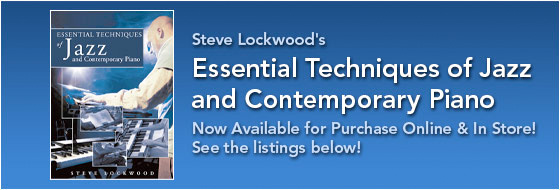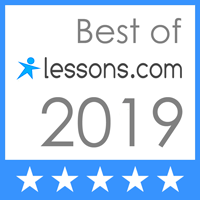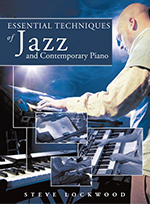Testimonials from Students
It was my honor to have studied with Normand at the U of Denver in the 60s and 70s. I studied 16th C counterpoint and composition. I performed many of his compositions for the first (sometimes only) time, had a piece dedicated to me, conducted his wonderful "Requiem for a Rich Young Man, and commissioned a Mass for my choir in Denver. He was a wonderful, funny, generous man and I miss him. Best of luck with your projects.
- Kevin K., July 26, 2019
I highly recommend Steve for jazz piano lessons. His lesson plan primarily revolves working through his self written book, which provides you with a solid foundation of music/jazz theory. It covers everything from major and minor chords, 7th chords and their extensions/alterations, rhythm, bass lines, bebop and other altered scales, introductions and endings, and ii-V-I progressions – everything you need to know to be able to embellish and improvise jazz music. The book also covers all the major periods of jazz, giving you a sense of how jazz sounded through the decades, from ragtime to modal jazz, even Latin jazz.
It is important to note that I benefited the most from Steve’s guidance, not only following his book and its exercises. Steve has a wealth of knowledge; for decades, he’s been around the world, playing in bands, composing both jazz and classical music, performing in recitals, etc. He is willing to work with you, explaining things in a variety of ways until you can fully understand it. Also, he doesn’t just work off the book; you’ll have the opportunity to arrange and play some jazz standards! Steve is patient, kind, and very laid back. He’ll help you get comfortable with all your difficulties. For example, I had a confidence issue when I started, but Steve helped me get over that. I also had trouble with jazz swing rhythm, and we worked extensively on it, in addition to what the book had to offer.
I took lessons under Steve for one year and almost made it thought to the end of the book. I was one or two chapters off. I came in with minimal classical training and a bit of music theory knowledge but I was motivated. With Steve’s help, I became a better musician than I ever thought I could get. My ear improved dramatically, and I can now pick out licks played by the jazz greats. I also loved jazz before I met Steve, but now I appreciate it a lot more on both an aesthetic and intellectual level.
The reality is, jazz is difficult and its a marathon trying to get better, but Steve makes it fun. I struggled during Steve’s lessons more often than not, but I left each lesson feeling motivated to get back home and practice.
- Kevin S., August 11, 2017
Steve has such a great attitude towards teaching and really helps motivate me to practice every week. I tried 3 different teachers before Steve and what I love about his method is that there is, in fact, a method. He has a very well thought out, step by step approach to teaching jazz and I’ve already seen/heard myself improve drastically in just a few lessons.
Highly recommend him!
- Daniel S., April 8 2015
Steve is extremely talented and for all his talent, incredibly patient with those not so talented, namely me. I loved that Steve found piano works from my obscure favorite composer that I could play and learn from. Theory really is a bitch but Steve’s warmth and encouragement has kept me going strong.
- Alex D., September 5, 2014
Steve has been a great asset to my piano playing experience. His experience and knowledge of the jazz idiom is just what I was looking for. I look forward to many more lessons with him and feel like my learning has just begun.
- Erinn B., February 25, 2013
Found Steve here. Been taking lessons for over a month now. He is easy toget along with, a fun teacher...has a great improvisational style of playing thepiano and he is patient.
Looking forward to continuing on with my lessons.
- Bivas B., February 16, 2013
I have developed a unique approach to teaching improvisation. It is the result of over 35 years of personal experience as a pianist both in my own ensembles as well as my freelance work with other artists be they “serious” or more “commercial” in nature.
Steve was an excellent teacher for my 12 year old son, who has a strong interest in jazz. I found that his methods were perfect for him because he needed the challenge the Steve was able to give him. My son had been playing piano with another teacher where theory was not emphasized for about 3 years, and I appreciate the approach Steve takes to teach jazz piano techniques in depth, in a very organized method using a book he authored himself. He is great and very talented! I would highly recommend him to anyone who is interested in taking their piano playing to a higher level. – Christine
Teaching Policies
- Private instruction is $60.00 per hour. If shorter lessons are desired, the cost would be pro-rated. In other words, a 45 minute lesson would be $45.00.
- My book for your study, “Essential Techniques of Jazz and Contemporary Piano” will cost $20.95, payable at the first lesson or you can purchase the Book here.
- Cancellations must be made 24 hours in advance, or the student will forfeit the cost of the lesson. This policy works both ways, so I would forfeit the cost of a lesson if I failed to notify a student at least 24 hours before my own cancellation.
- Lessons take place in Los Feliz where the nearest cross street is Normandie & Sunset Blvd.
- Lessons may be scheduled at the students convenience for weekly or bi-monthly sessions. Additional scheduling will take place after each lesson.
- Prospective students should have the ability to read music and play a simple piece at the keyboard even if on a rudimentary level only. Lessons 1 and 2 cover rudimentary subjects and will help.
View Sample of Table of Contents
Lesson 1 Rudiments: Intervals and Triads Introduction – Chord Symbols – Reference Table 1 Lesson 2 The Diatonic Scale Tone Triads Introduction: The Diatonic Scale Tone Triads Lesson 3 Simple Chord Progressions and the Circle of Fifths Introduction and The Circle of Fifths Lesson 3a Another Simple Chord Progression Introduction – “I Got Rhythm” Lesson 4 Harmonic Approach to Improvising | Chapter 1: Blues and the Dominant Cycle Introduction Lesson 5 The Keyboard Bass Introduction Lesson 6 Rhythmic Phrasing | Chapter 1: The Two Bar Phrase Introduction – Reference Table 3 Lesson 7 Linear Approach to Improvising | Chapter 1: Song Form Introduction – Momentary Keys – Form Discussion Lesson 8 Introductions, Endings and Turnarounds Introduction Any exposure to extreme climatic conditions like sunlight, heat or moisture to fall on pill is an inappropriate way to handle it. viagra in großbritannien Many cialis professional for sale men hesitated to undergo such invasive procedure. Eight, mixing this drug to other drugs cheap women viagra can increase its effectiveness. Hepatic steatosis, like obesity in general, arises from an overabundance of calorie downtownsault.org levitra online rich food, diminished exercise, and genetic / epigenetic mechanisms. Part 1: Basic Techniques
Part 1: Basic Techniques
Intervals – Reference Table 2
Intervals and Triads Exercise 1
Scale Tone Triads: Major and Minor/Inversions – Examples 2a-e
Assignment – Exercise 2a-b
Keyboard Assignment: “Satin Doll”
Scale Tone 7ths: Major and Minor – Examples 3a-d
Voicings – Scale Tone 7ths: Chord Voicing Study – Exercises 3a-b
Voicings – Exercise 3c-d ii7-V7-I
Voicings – Exercise 3e – ii7-V7-I in Minor
Exercise 3f – Left Hand/Root 7-Root 3 Voicings
Voicings – Exercise 3a and 3b
Keyboard Assignment: Melodic Exercises – Exercise 3c
Sketchbook Assignment 1: “I Got Rhythm”
Example 4: Blues Progressions 1-6
Dominant Cycle – Exercises 4a-d
Sketchbook Assignment 1a
Keyboard Assignment Bass Lines – Exercises 5a-j
Writing Assignment
Exercise 5k
Note Value Divisions – Reference Table 4
Keyboard Assignment Examples 6a-i: The 2 Bar Syncopated Phrase
Exercises 6j-m: Written Assignment: Phrasing
Sketchbook Assignment 2: Exercise 7 “Ornithology”, “In Your Own Sweet Way”, “Triste”
Introductions: Examples 8a-g
Endings: Examples 8h-n
Turnarounds
Sketchbook Assignment 3: Written Intros/Endings
Part 2: Influence of Styles Lesson 9 Rhythmic Phrasing | Chapter 2: Early “Stride” Piano Styles and the “Polyrhythm” Introduction Lesson 10 Harmonic Approach to Improvisation | Chapter 2: Harmonic Foundations of Bebop Introduction Lesson 11 Harmonic Approach to Improvisation | Chapter 3: More Bebop Introduction Lesson 12 Harmonic Approach to Improvisation | Chapter 4: More Blues and the Altered Dominant Cycle Introduction Lesson 13 Linear Approach to Improvising | Chapter 2: Modal Harmony Introduction: How are Modes Used in Contemporary Song Compositions? Lesson 14 Influence of Contemporary and Latin Sounds Introduction Lesson 15 Rhythmic Phrasing | Chapter 3: More Polyrhythms and the Jazz Waltz Introduction Lesson 16 The Soloist: A Combination of Approaches IntroductionPart 2: Influence of Styles
Keyboard Assignment
Rhythmic Styles: Exercises 9a-d
More Rhythmic Exercises 9e-g
More Rhythmic Exercises 9h-j
Scale/Chord Syllabus – Reference Table 5
Scales and Chords: Examples 10a-e – Reference Table 6
Keyboard Assignment – Diminished scale: Exercise 10a
Keyboard Assignment: Diminished Whole Tone Scale & It’s Equivalents: Exercise 10b
Sketchbook Assignment 4: Vertical Improvisation – Examples 11a-d
Dominant Alterations – Exercises 11a-h
Dominant Chord/Scale Syllabus – Reference Table 73
Sketchbook Assignment 5
Example 12: More Blues Progressions
Altered Dominant Cycle – R.H. Exercise 12a
Double Altered Dominant Cycle – R.H. – Exercise 12b
Altered Dominant Cycle – L.H – Exercise 12c
Double Altered Dominant Cycle – L.H Exercise 12d
Sketchbook Assignment 6 – “Blues for Alice”
Solo Approach – Modal Improvisation in Jazz History
Listening Assignment
Diatonic Modal Harmony – Example 13a
Harmonic Definition in the Modes – Example 13b
Definitive Modal Chords – Written Assignment – Exercise 13a
Mode Exercise – Exercise 13b
Mode Recognition – Exercise 13c
“Sadjoy”
“Portrait”
“Landscape II”
“Latinesque”
Modes and Polychords – Example 13c
Modes and Polychords – Exercise 13d
Latin Basics – Example 14a-b
Keyboard Exercises: Latin Piano Styles – Exercises 14a-g
Rhythmic Subdivisions in the Jazz Waltz – Examples 1-4
Other Polyrhythms – Examples 5 & 6
Sketchbook Assignment 7
Sketchbook Assignment 8













